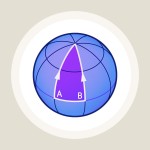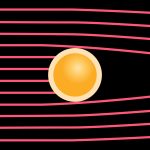Step by step from Newton to Einstein
How the discrepancies of Newton’s and Einstein’s theories – and the transition from one theory to the other – can be systematically recorded.
An article by Gerhard Schäfer
On Earth and generally everywhere in our solar system, the gravitational field is, for cosmic terms, weak. Thanks to that circumstance, the gravitational field and as a consequence also the motion of the celestial bodies of the solar system can be described very well with the help of the Newtonian theory of gravity. Only when observed over long periods of time, the movements of the celestial bodies deviate slightly from the predictions of the Newtonian theory of gravity. For example, the Mercury orbit shows a tiny shift of the orbit point closest to the Sun, which Newton’s theory of gravity cannot explain. This so-called anomalous perihelion rotation amounts to only 43 arc seconds per century. Only Einstein succeeded in a convincing explanation of this effect with his theory of gravitation, the general theory of relativity.
With stronger gravity, the differences become more obvious, and then it becomes apparent that Einstein’s theory retains its validity, while the discrepancies between Newton’s theory and astronomical observations become larger and larger. One example is the binary pulsar system PSR J0737-3029A/B, discovered in 2003, which consists of two neutron stars orbiting each other while still rotating themselves. The orbital curves of these pulsars show a displacement analogous to the perihelion rotation of Mercury, which, however, amounts to a considerable 17 angular degrees per year and is thus about a hundred thousand times larger than that of Mercury! Here the calculations in the context of the theory of general relativity must be carried out very exactly, in order to be able to keep up with the observation accuracy.
The best of both worlds
Each of the two theories – Einstein’s and Newton’s – has advantages and disadvantages. Mathematically, the Newtonian theory of gravity is much simpler than Einstein’s. The Newtonian description of two bodies orbiting each other succeeds with mathematical methods, which are nowadays material of the beginners’ lecture in physics studies. In the framework of general relativity, however, the exact description of this situation is still an unsolved problem.
The weakness of Newton’s theory has already been mentioned. Its predictions, for example for the orbits of celestial bodies, deviate from real conditions – very little at first, but more and more with increasing time. In the case of a binary pulsar, for example, the predictions of the Newtonian description agree with the observations only for such periods which are small compared to the orbital period. For our solar system, on the other hand, the Newtonian theory of gravity can make predictions over much larger sections of orbits of celestial bodies that are compatible with actual observations.
To take advantage of both formulations, physicists have developed an approximation procedure that starts with Newtonian gravity and then adds, step by step, the corrections that result from the more complete description of general relativity – allowing deviations of Einstein’s theory from Newton’s to be captured with mathematical precision. This results in the extremely useful so-called post-Newtonian expansions. With their help, certain situations can be described whose exact modeling is currently impossible within the framework of general relativity, but which, on the other hand, contain elements (such as gravitational waves) that are foreign to Newtonian theory. One example is the description of a binary star system radiating gravitational waves. The approximation is not applicable to all conceivable situations (for example, not to questions of cosmology), but it proves to be a valuable tool for a variety of astrophysically interesting situations.
A question of velocities
How can we systematically judge when a situation is sufficiently well described by Newtonian theory and when effects of general relativity become important? As it turns out, the decisive quantity is the speed of light.
As in special relativity, the speed of light is an upper speed limit in general relativity for all bodies and particles which have mass. On the other hand: In order to accelerate particles to high velocities, there must be forces. In electrodynamics and also in gravitation theory, the concept of potentials can be introduced. It is closely related to the concept of energy; in the case of gravitation, for example, the gain in kinetic energy of a test particle moving from a distant location A closer to a mass, namely to location B, is the difference of the potential values belonging to locations B and A, multiplied by the mass of the test particle.
Also in general relativity, a kind of potential can be defined, which in the limiting case of weak gravity turns into the Newtonian gravitational potential (in fact, there is even more than one possibility for this definition). The potential expression is closely related to the influence of gravity on the rate of clocks and the frequency of light. Its physical dimension is, just like Newton’s, “velocity squared”. The value of the potential for places which are infinitely far away from all masses and other gravitational sources of the considered system is usually set to zero. Under this condition it is shown that there is also an absolute upper limit for the magnitude of the gravitational potential. For one of the possible definitions of the potential, this upper limit is the square of the speed of light divided by two (the division by two is a consequence of the definition of the term “gravitational potential” in the Newtonian theory).
After these preliminary considerations, it can be stated more precisely under which conditions the Newtonian theory yields the same predictions as Einstein’s theory in good approximation: namely, when the gravitational potentials are very small compared to their maximum amount – the velocity of light squared and divided by two – and when the velocities of all particles involved are small compared to the speed of light.
Step by step from Newton to Einstein
With these considerations in mind, one arrives at the post-Newtonian approximations as follows: At the heart of General Relativity are Einstein’s equations, which describe the relationship between the geometry of spacetime and certain properties – such as the mass – of the matter present. If we are dealing with a situation in which a number of separable bodies act on each other via gravity, then Einstein’s equations determine, among other things, how the bodies move under the mutual gravitational influence. Expressed in terms of a physicists, the equations of motion of the concerning bodies follow from the Einstein equations.
The Einstein equations generally lead to very complicated expressions, and it will usually not be possible to derive exactly how the motion of such bodies proceeds. However, for comparatively small velocities and correspondingly small gravitational potential differences, there is a possibility to write down the equations of motion in a particular way: as a sum of different contributions, each preceded by a certain power of the inverse speed of light squared. In some of them the speed of light does not occur at all (differently expressed: in the zeroth power); in front of other terms 1/c² with c as the speed of light is just the first power of the expression “one by the speed of light squared”, while a term 1/c4 contains the second power, and accordingly at higher powers. However, odd powers also occur in the further terms, namely 1/c5 and so on.
Those terms, in which the speed of light does not occur at all, lead to the equations of the Newtonian theory of gravity. All further terms supply corrections to the Newtonian theory, step by step. Assume v is a typical velocity of the bodies concerned. We assumed these velocities to be very small compared to the speed of light, in other words: the fraction v/c is much smaller than one. Therefore obviously terms e.g. of the order (v²/c²)² are much larger than terms of the order (v²/c²)4. The same applies accordingly to the ratio of the gravitational potentials to the square of the speed of light.
This allows physicists to make specific trade-offs when modeling bodies under mutual gravitational influence. In many situations, for example, gravity is so weak compared to the maximum possible value that it is sufficient to consider only terms up to the first power of 1/c², thus simplifying the calculations considerably. In this case, one speaks of the first post-Newtonian approximation (1pN). More generally, if all terms up to and including the nth power of 1/c² are considered, it is the nth post-Newtonian approximation (npN).
The meaning of the individual steps
The “zeroth post-Newtonian approximation” corresponds, as said, to Newtonian physics. Here, in the case of, say, a two-body system, the motion of the two bodies follows Kepler’s laws, which have been known for a long time. Each additionally considered class of terms brings the physicists from the Newtonian theory one step further toward general relativity.
The first deviation from Newton’s equations of motion is the approximation 1pN. Its correction terms already describe a number of the classical effects of general relativity. These include, first, the anomalous perihelion rotation (and its analogue in binary stars) and the so-called de Sitter precession – tiny, periodic changes in the relative orientation of the orbital planes of the Earth-Moon system and the Sun-Earth system.
In addition, the gravitational potentials that enter into the equations of motion of the 1pN approximation can be used to calculate the propagation of light in gravitational fields to 1pN accuracy. This then results in the famous deflection of light, first measured in 1919 during a solar eclipse. Shapiro’s time delay effect of light signals in gravitational fields, which was first measured in 1964 with radar signals reflected from Venus, is also captured by this description. Similarly, the 1pN approximation already describes effects of the rotation of a mass on gyroscopes, orbits, and light propagation in its vicinity – effects of so-called gravitomagnetism.
The second deviation 2pN does not lead to qualitatively new phenomena, but allows to calculate the already mentioned effects with higher accuracy.
In the Newtonian description as well as with 1pN and 2pN, the following applies: If the system is isolated – think of the ideal picture of two neutron stars orbiting each other in an otherwise empty cosmos – then its total energy remains unchanged. However, this changes with the approximation 2.5pN. From this approximation onwards, the retroaction of the emitted gravitational waves is taken into account, i.e. the fact that, for example, a binary star system loses energy by emitting gravitational waves and that the stars therefore come closer and closer to each other with time. This effect is the basis of the first indirect detection of gravitational waves by means of the binary pulsar PSR 1913+16, which succeeded for the first time in 1978.
After that comes again a stage with correction terms, which do not influence the total energy of the system further, 3pN, and then the next stage, in which the new correction terms cause a loss of energy, 3.5pN. For two orbiting very compact objects such as neutron stars and/or black holes, the terms can be calculated explicitly up to this order. These orders are important only for gravitational wave astronomy, because only by measuring the radiated gravitational waves it will be possible to obtain data on the motions of binary star systems, whose accuracy requires such a precise theoretical description.
From the 4pN level onwards, the post-Newtonian expansions turn out to be very complicated. The physical background is that then, the influence of gravity on the gravitational waves themselves needs to be accounted for. Also, from here onwards the corresponding powers of 1/c² appear not only as prefactors, but as arguments of logarithm functions. Here begins the realm of the so-called generalized post-Newtonian approximations, which we do not want to go into here.
For the sake of completeness, however, it should be added that also in the description of gravitational waves it is spoken of a certain wave being “of nth post-Newtonian approximation”. What is meant then is that the nth post-Newtonian approximation was used in the description of the system of bodies which produced this gravitational wave.
What about black holes?
The attentive reader will have noticed that we have already briefly addressed the case of orbiting black holes, and may have wondered how this fits together: Aren’t black holes the most powerful gravitational sources of all? Can they then be described within the framework of an approximation that takes advantage of the fact that the gravitational effects are comparatively weak?
The answer is: No and Yes. If we want to describe the immediate neighborhood of the black hole, for example its horizon, then the post-Newtonian approximation indeed falls short, and one must calculate entirely within the framework of general relativity.
The situation is different if we are only interested in how the black hole affects world events from a distance – for example, if we are talking about two black holes orbiting each other at some distance. Just as in Newton’s theory, the strength of the gravitational effect decreases rapidly with increasing distance in Einstein’s theory; when the black holes are so far apart that they experience only a relatively weak gravitational effect from the other, their relative motion can be well described within the framework of post-Newtonian approximations.
Similarly, the orbital velocities of orbiting black holes can serve as a decision criterion: Black holes that orbit extremely closely move at velocities close to the speed of light – a clear indication that the post-Newtonian approximations cannot be meaningfully applied here. In contrast, for black holes orbiting farther apart, the orbital velocities are small compared to the speed of light.
Applications
The most important among the post-Newtonian approximations is the first approximation (1pN) – the corrections it contains are the largest and thus the easiest to measure. Accordingly, the 1pN approximation plays the dominant role in the solar system with its many observational possibilities. For example, the modern ephemeris programs are based on it, which help computers to calculate the orbital data of the Earth’s moon, all planets and large asteroids of our solar system.
The Global Positioning System (GPS) is also a beneficiary of the 1pN approximation. However, at the current accuracy of this navigation system, it only comes into play when it is necessary to calculate the rate differences between Earth-based clocks and the on-board clocks of GPS satellites.
The applications of the 1pN approximation in the astrophysics of neutron star systems have already been mentioned several times in the text. Another application is gravitational lensing astronomy – the 1pN approximation is also used in calculations of how a particular mass distribution deflects the light from sources behind it, and consequently how certain gravitational lensing phenomena occur.
Another application is that a generalization can be developed from the 1pN approximation in which one can quantitatively state how well the predictions of Einstein’s theory and similar theories agree with observations and measurements. A separate spotlight article is devoted to this so-called “parameterized post-Newtonian formalism”: A test-bed for the General Theory of Relativity.
Further Information
Background knowledge on this spotlight topic can be found in the section General Relativity of Elementary Einstein.
Related spotlights on Einstein Online can be found in the category General Relativity.
Colophon
Gerhard Schäfer is Professor of Theoretical Physics and Relativistic Astrophysics at the Friedrich Schiller University in Jena.
Citation
Cite this article as:
Gerhard Schäfer, “Step by step from Newton to Einstein” in: Einstein Online Band 13 (2021), 1002










